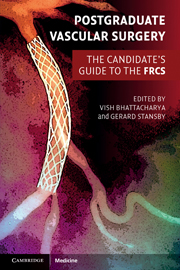Book contents
- Frontmatter
- Contents
- List of contributors
- Preface
- Section 1 Final FRCS vascular clinicals
- Section 2 Final FRCS vascular topics
- 1 Vascular risk factors and their management
- 2 Management of acute limb ischaemia
- 3 Chronic lower limb ischaemia, critical ischaemia and the diabetic foot
- 4 Endovascular and surgical options for peripheral revascularisation
- 5 Abdominal aortic aneurysms
- 6 Thoracic, thoracoabdominal and suprarenal aortic aneurysms
- 7 Aortic dissection
- 8 Popliteal artery aneurysms
- 9 Femoral artery aneurysms
- 10 Carotid, subclavian and vertebral disease
- 11 Diagnosis and management of thoracic outlet syndrome
- 12 Diagnosis and management of hyperhidrosis
- 13 Chronic mesenteric ischaemia
- 14 Acute ischaemic colitis
- 15 Vascular trauma
- 16 Indications and management of lower limb amputation
- 17 Leg swelling and lymphoedema
- 18 Varicose veins and chronic venous insufficiency
- 19 Management of deep vein thrombosis
- 20 Infection in vascular surgery
- 21 Vascular malformations
- 22 Vasospastic disorders and vasculitis
- 23 Critical care considerations and preoperative assessment for general and vascular surgery
- 24 Access surgery
- 25 Basic outline of solid organ transplantation
- Index
- References
16 - Indications and management of lower limb amputation
- Frontmatter
- Contents
- List of contributors
- Preface
- Section 1 Final FRCS vascular clinicals
- Section 2 Final FRCS vascular topics
- 1 Vascular risk factors and their management
- 2 Management of acute limb ischaemia
- 3 Chronic lower limb ischaemia, critical ischaemia and the diabetic foot
- 4 Endovascular and surgical options for peripheral revascularisation
- 5 Abdominal aortic aneurysms
- 6 Thoracic, thoracoabdominal and suprarenal aortic aneurysms
- 7 Aortic dissection
- 8 Popliteal artery aneurysms
- 9 Femoral artery aneurysms
- 10 Carotid, subclavian and vertebral disease
- 11 Diagnosis and management of thoracic outlet syndrome
- 12 Diagnosis and management of hyperhidrosis
- 13 Chronic mesenteric ischaemia
- 14 Acute ischaemic colitis
- 15 Vascular trauma
- 16 Indications and management of lower limb amputation
- 17 Leg swelling and lymphoedema
- 18 Varicose veins and chronic venous insufficiency
- 19 Management of deep vein thrombosis
- 20 Infection in vascular surgery
- 21 Vascular malformations
- 22 Vasospastic disorders and vasculitis
- 23 Critical care considerations and preoperative assessment for general and vascular surgery
- 24 Access surgery
- 25 Basic outline of solid organ transplantation
- Index
- References
Summary
Key points
Peripheral vascular disease is the leading cause of amputation in the Western world
Diabetics are 8–12 times more likely to suffer amputation
Mortality and subsequent loss of the contralateral limb following amputation is high
The level of amputation requires careful consideration of the rehabilitative potential of the patient, level and pattern of vascular disease and likely healing
Careful preoperative assessment and periopertive care using the multidiscliplinary team is essential for successful outcomes
Epidural analgesia provides the best perioperative analgesia but does not prevent subsequent phantom pain
The general principles of amputation surgery apply to all sites of amputation
Rehabilitation of the patient should start immediately postoperatively
Postamputation pain is the commonest postoperative complication, is multifactorial and requires thorough assessment and possible onwards referral to a multidisciplinary pain team for management
Phantom limb pain is common and effective treatments remain elusive
History of amputation
Amputation, derived from the latin amputare, ‘to cut away’, is one of the oldest surgical operations. The first recorded amputation appears in the book of the Vedas, written in Sanskrit in India, dated between 3500 and 1800 BC. It records that the leg of Queen Vishpla was amputated in battle, and after healing, an iron leg was fitted to enable the Queen to return to the battlefield.
The early descriptions of amputation by Hippocrates and Celsus focused on amputation for the treatment of gangrene.
- Type
- Chapter
- Information
- Postgraduate Vascular SurgeryThe Candidate's Guide to the FRCS, pp. 183 - 194Publisher: Cambridge University PressPrint publication year: 2011

